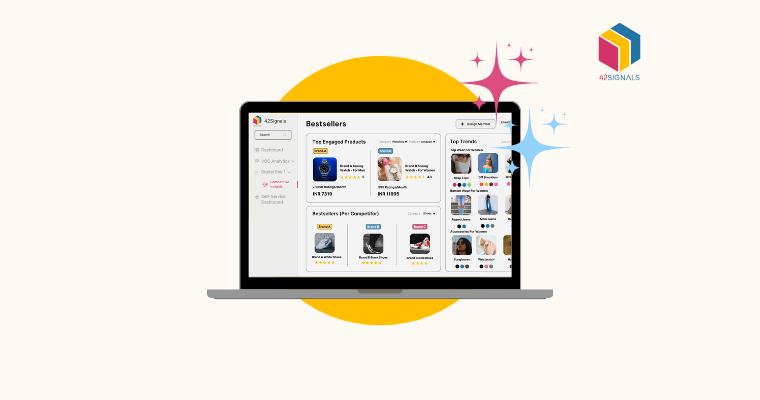What is eCommerce Price Monitoring?
Ecommerce price monitoring refers to tracking and analyzing the prices of products sold by online retailers. eCommerce price tracker helps businesses to stay competitive by keeping track of the prices of their competitors and adjusting their own pricing strategies to attract customers.
Ecommerce price monitoring can be used to monitor prices on various ecommerce platforms and marketplaces, including Amazon, eBay, etc. as well as individual ecommerce websites. Some ecommerce price tracker tools provide real-time price monitoring, allowing businesses to adjust their prices in response to changes in the market.
It involves using tools that offer insights on product prices, customer reviews,, and other relevant information which can be leveraged to identify trends in pricing, identify competitors’ pricing strategies, and adjust pricing accordingly.
Effective ecommerce price monitoring can help businesses optimize their pricing strategies, reduce costs, and increase sales. It can also help identify opportunities to enter new markets or expand their product offerings.
Monitor Price Changes in the Marketplace
There are several ways to monitor your online prices, depending on your budget and the level of detail you require. Here are a few options:
- Use price monitoring tools: Price monitoring tools such as 42Signals, Price2Spy and Prisync etc. can provide you with real-time updates on pricing trends and allow you to set up alerts for price changes.
- Web scraping services: If you have a large number of products and competitors, you may want to consider hiring a web scraping service provider to monitor your online prices. These services can provide in-depth analysis of pricing trends and help you make informed pricing decisions.
- Manual monitoring: For a small number of products and competitors, you can monitor prices manually by regularly checking competitor websites and making note of any price changes. This can be time-consuming, but is free and can provide valuable insights into your competitors’ pricing strategies.
How Do You Track Competitor Pricing
Here are some tips for tracking competitor pricing:
- Identify your key competitors: Start by identifying the competitors that are most relevant to your business including those who sell the same or similar products as you, as well as those who sell substitute products.
- Focus on key products: It’s not necessary to track every product that your competitors sell. Instead, focus on the products that are most important to your business and where you face the most competition.
- Monitor promotions: Don’t just track your competitors’ regular prices. Also monitor any promotions or discounts that they offer, such as sales or coupons.
- Analyze pricing trends: Look for pricing trends over time, such as whether your competitors tend to lower their prices during certain seasons or holidays.
- Look beyond pricing: Consider other factors that may give your competitors an edge, such as shipping costs, customer service, or product quality.
To track competitors pricing, you can use a variety of methods and tools, including:
- Manual monitoring
- Price monitoring tools
- Web scraping service providers
- Data providers
Regardless of the method you choose, it’s important to track competitors’ pricing regularly to ensure that you remain competitive in the marketplace and make informed pricing decisions that help you maximize your profits and grow your business.
Top Competitor Price Tracker Tools
There are many competitor price tracking tools available on the market, each with its own features and pricing. Here are some of the top competitor price tracking tools:
- 42Signals
- Price2Spy
- Prisync
- Incompetitor
- Kompyte
When choosing a competitor price tracking tool, you might want to consider your budget, the number of products and competitors you want to track, and the level of detail you require. It’s also important to choose a tool that provides easy-to-use analytics and reporting.
How 42Signals Can Help with eCommerce Price Tracking
42Signals can help with ecommerce price tracking by providing you with valuable insights into product pricing, competitor pricing, customer behavior, and digital shelf analytics. Here are a few ways it can help:
- Competitive price monitoring: It allows you to track your competitors’ prices and receive real-time alerts when they change. This can help you stay competitive in the market and adjust your pricing strategy as needed. eCommerce price tracker can help you set the right prices for your products in different marketplaces.
- Price optimization: It can analyze customer behavior and pricing trends to help you optimize your pricing strategy.
- Digital shelf analytics: It can also help you analyze your product assortment and pricing strategies across different product categories and identify and address issues such as out-of-stock products, poor product ratings, or negative customer reviews.
- Dynamic pricing: It allows you to adjust your prices in real-time based on changes in market demand, competitor pricing, and other factors.
By leveraging the insights and capabilities offered by 42Signals, you can gain a competitive edge in the ecommerce marketplace. It can help you track your competitors’ pricing, optimize your pricing strategy, and make data-driven decisions that drive online sales and revenue.




